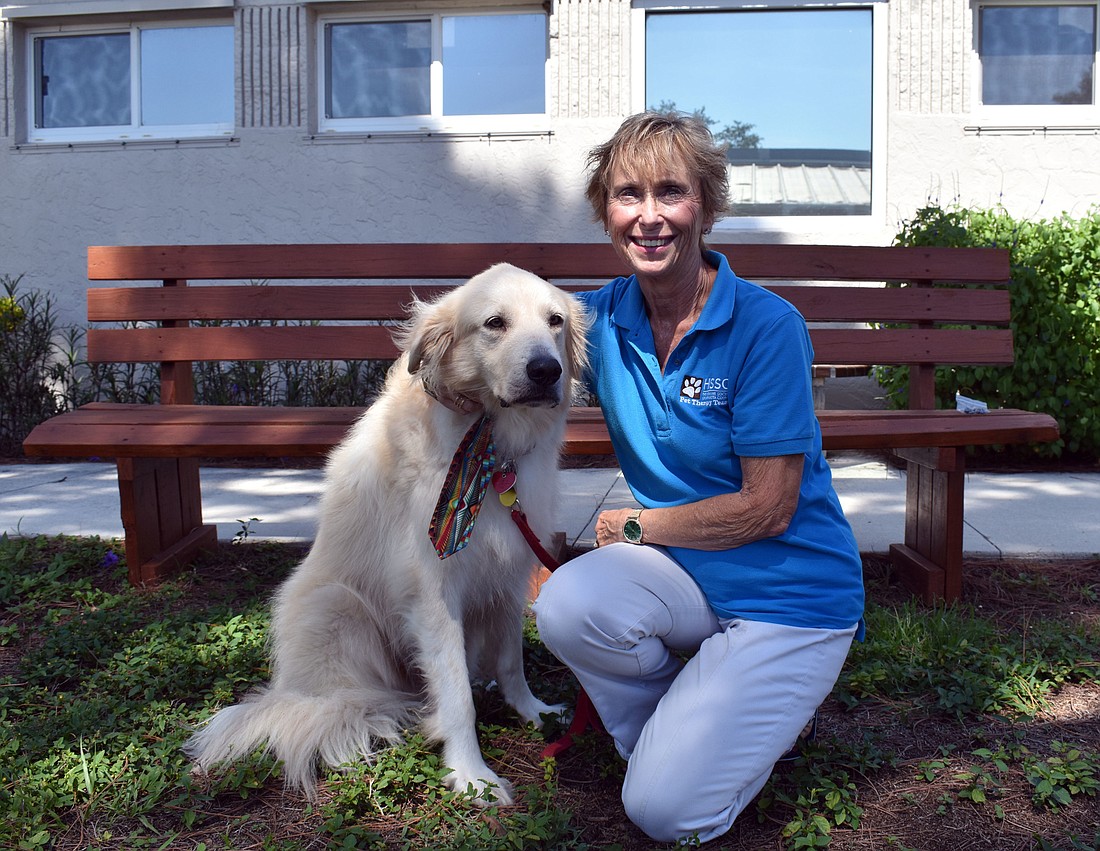- January 12, 2025
-
-
Loading

Loading

Each morning, he wakes up, eats his breakfast, puts on his tie and goes to work.
The catch? This employee has four legs and fur.
Three to four times a week, Lance dons one of his 10 ties and, with his human, Nan Miller, in tow, heads out to provide comfort and affection to various groups throughout Sarasota County.
“My dear friend calls him a four-legged Xanax,” Miller said. “People will just pet him and say he exudes calming energy. I don’t know what it is, but he just calms people down.”
The Great Pyrenees mix is one of the nearly 100 pet therapy dogs in the Humane Society of Sarasota County pet therapy program.
The program was revamped three years ago, and since then, Ginny Armington, the HSSC community outreach coordinator, said it has grown exponentially.
Volunteers regularly visit more than 50 organizations throughout the Sarasota community, such as senior facilities, schools, hospitals and veterans gatherings. While at the various locations, the dogs provide comfort and joy to those in need.
“Because we’re a nonprofit, it’s the community that supports us,” Armington said. “We don’t get any other funds. It’s just everybody making donations. So this is our way of giving back to the community.”
Because the program is volunteer-based, around 10 dogs will typically go to any given event, Armington said. However, if a tragedy occurs, such as the death of a student, that number will usually double.
Miller said she enjoys going to the events with Lance because she sees the effect he has on people.
“There’s just something about his soul, and that’s the way it is with a lot of these dogs,” she said. “They just have a gentleness, a kindness, an understanding when somebody needs them.”
Miller recalled a visit she and Lance made to an assisted living facility. She approached a woman in a wheelchair and asked if she liked dogs. The woman said yes, and the two began to chat.
On her way out, an employee approached Miller and said, “I just want you to know she’s never spoken before.”
“It was absolutely amazing,” Miller said. “[These dogs] are able to dig down into somebody’s deepest parts of their hearts, of their memories.”
While the dogs provide emotional support, they also provide the HSSC an opportunity to educate the public. Armington said the HSSC uses the pet therapy dogs to teach people best pet practices and how to be more humane with animals.
“With kids, some of them don’t learn compassion or empathy, and the animals are a great way to help teach them that,” she said. “When I take pet therapy teams with me, that interaction with the dogs, to me, is what creates empathy and kindness.”
“I did nothing. It was just born in him. He is this way." — Nan Miller
But humans aren’t the only ones getting something out of the program. Armington said all the pet therapy dogs enjoy having a job.
“The dogs have fun,” she said. “A lot of dogs need a job or a purpose. The minute they see their human put on an HSSC polo, they get excited because they know they’re going to work.”
Any dog can become a pet therapy dog, Armington said, so long as they’re willing to work. To become a therapy dog, the dog and a human volunteer will go through a four-week training course with HSSC.
If the dog shows a willingness to work along with what Armington calls “the right stuff,” then the dog will be certified and can begin volunteering.
What is the right stuff? Like Lance’s calm demeanor, it’s the characteristics that dogs naturally posses, Armington said.
“People say all the time, ‘What did you do to train him?’” Miller said. “I did nothing. It was just born in him. He is this way.”